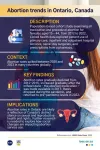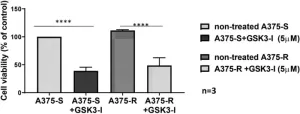(Press-News.org) Beams of light that can be guided into corkscrew-like shapes called optical vortices are used today in a range of applications. Pushing the limits of structured light, Harvard applied physicists in the John A. Paulson School of Engineering and Applied Sciences (SEAS) report a new type of optical vortex beam that not only twists as it travels but also changes in different parts at different rates to create unique patterns. The way the light behaves resembles spiral shapes common in nature.
The researchers borrowed from classical mechanics to nickname their never-before-demonstrated light vortex an “optical rotatum,” to describe how the torque on the light’s corkscrew shape gradually changes. In Newtonian physics, “rotatum” is the rate of change in torque on an object over time.
The optical rotatum was created in the lab of Federico Capasso, the Robert L. Wallace Professor of Applied Physics and the Vinton Hayes Senior Research Fellow in Electrical Engineering at SEAS. “This is a new behavior of light consisting of an optical vortex that propagates through space and changes in unusual ways,” Capasso said. “It is potentially useful for manipulating small matter.” The research is published in Science Advances.
In a peculiar twist, the researchers found that their orbital angular momentum-carrying beam of light grows in a mathematically recognizable pattern found all over the natural world. Mirroring the Fibonacci number sequence (made famous in The Da Vinci Code), their optical rotatum propagates in a logarithmic spiral that is seen in the shell of a nautilus, the seeds of a sunflower, and the branches of trees.
“That was one of the unexpected highlights of this research,” said first author Ahmed Dorrah, a former research associate in Capasso’s lab, now an assistant professor at Eindhoven University of Technology. “Hopefully we can inspire others who are specialists in applied mathematics to further study these light patterns and gain unique insights into their universal signature.”
The research builds on previous work in which the team used a metasurface, a thin lens etched with light-bending nanostructures, to create a light beam with controlled polarization and orbital angular momentum along its propagation path, converting any input of light into other structures that change as they move. Now, they’ve introduced another degree of freedom to their light, in which they can also change its spatial torque as it propagates.
“We show even more versatility of control, and we can do it continuously,” said Alfonso Palmieri, a graduate student in Capasso’s lab and co-author of this research.
Potential use cases for such an exotic beam of light include the control of very small particles, such as colloids in suspension, by introducing a new type of force in accordance with the light’s unusual torque. It could also enable a precise optical tweezer for micro-manipulation of small things.
While others have demonstrated torque-changing light using high-intensity lasers and bulky setups, the Harvard team made theirs with a single liquid crystal display and a low-intensity beam. By showing they can create a rotatum in an industry-compatible, integrated device, the barrier to entry for their technology to become reality is much lower than previous demonstrations.
The paper was co-authored by Lisa Li in the Capasso Group. Federal funding for this research came from the Office of Naval Research MURI program under grant No. N00014-20-1-2450 and the Air Force Office of Scientific Research under grant No. FA9550-22-1-0243.
END
Light that spirals like a nautilus shell
‘Optical rotatum’ describes new structure of light
2025-04-11
ELSE PRESS RELEASES FROM THIS DATE:
Transforming doors into gateways to the virtual world: the future of mixed reality!
2025-04-11
Ikoma, Japan—People seeking to feel fully immersed in virtual environments will soon be able to experience a revolutionary approach to spatial computing that bridges the gap between real and digital worlds. A collaborative research team from NTT DOCOMO, Inc. and Nara Institute of Science and Technology (NAIST), Japan, has developed a novel mixed reality (MR) technology that transforms how users interact with virtual spaces by using everyday real-world doors as natural transition points.
Virtual reality (VR) and MR technologies have ...
AACR announces recipients of the 2025 AACR June L. Biedler Prize for Cancer Journalism
2025-04-11
PHILADELPHIA – The American Association for Cancer Research (AACR) is pleased to announce the recipients of the 2025 AACR June L. Biedler Prize for Cancer Journalism in the following categories:
Magazine
“Targeting Cancer, Sparing Patients”
By Jyoti S. Madhusoodanan (Photo), Scientific American
Newspaper
“Fighting stigma, fighting cancer: The rising threat of male breast cancer in Kenya”
By Pauline Ongaji Ogada (Photo), Nation
Online/Multimedia
“Farewell, my stomach”
By Teresa Firmino (Photo) and Joana Martins Gonçalves (Photo), Publico
“Women ...
Human-AI relationships pose ethical issues, psychologists say
2025-04-11
It’s becoming increasingly commonplace for people to develop intimate, long-term relationships with artificial intelligence (AI) technologies. At their extreme, people have “married” their AI companions in non-legally binding ceremonies, and at least two people have killed themselves following AI chatbot advice. In an opinion paper publishing April 11 in the Cell Press journal Trends in Cognitive Sciences, psychologists explore ethical issues associated with human-AI relationships, including their potential to disrupt human-human relationships and give harmful advice.
“The ...
Abortion rates remain relatively stable in Canada, while rates spike in UK, Europe, and US
2025-04-11
Vancouver, BC, April 11, 2025 – A new study finds that, unlike countries across the UK and Europe, abortion rates did not spike in Ontario, Canada from 2020-2022.
Following decades-long declines in nearly all high-income settings, abortion rate trends reversed between 2020 and 2022 in many countries. For example, 2022 and 2023 saw the highest abortion rates on record in Scotland, England, and Wales.
Researchers from the University of British Columbia and ICES found that, after accounting for changes in the abortion rate when the ...
Hundred-year storm tides will occur every few decades in Bangladesh, scientists report
2025-04-11
Tropical cyclones are hurricanes that brew over the tropical ocean and can travel over land, inundating coastal regions. The most extreme cyclones can generate devastating storm tides — seawater that is heightened by the tides and swells onto land, causing catastrophic flood events in coastal regions. A new study by MIT scientists finds that, as the planet warms, the recurrence of destructive storm tides will increase tenfold for one of the hardest-hit regions of the world.
In a study that will appear in One Earth, the scientists ...
Kidney function following COVID-19 in children and adolescents
2025-04-11
About The Study: In this large U.S. cohort study of children and adolescents, SARS-CoV-2 infection was associated with a higher risk of adverse postacute kidney outcomes, particularly among those with preexisting chronic kidney disease or acute kidney injury, suggesting the need for vigilant long-term monitoring.
Corresponding Author: To contact the corresponding author, Yong Chen, PhD, email ychen123@pennmedicine.upenn.edu.
To access the embargoed study: Visit our For The Media website ...
Risk factors for severe disease among children hospitalized with RSV
2025-04-11
About The Study: In this cohort study of children hospitalized with respiratory syncytial virus (RSV) in 2022 and 2023, severe RSV disease was more likely among those age 2 or older with pulmonary and neurologic, neuromuscular, or developmental conditions. For children younger than 2 years, age younger than 6 months and prematurity were the main risk factors. These findings support prevention strategies for all younger children, including premature infants, with potential benefit for children age 2 or older ...
Watch a live catalytic event in real time
2025-04-11
A Northwestern University-led international team of scientists has, for the first time, directly observed catalysis in-action at the atomic level.
In mesmerizing new videos, single atoms move and shake during a chemical reaction that removes hydrogen atoms from an alcohol molecule. By viewing the process in real time, the researchers discovered several short-lived intermediate molecules involved in the reaction as well as a previously hidden reaction pathway.
The observations were made possible by single-molecule atomic-resolution time-resolved electron microscopy (SMART-EM), a powerful instrument that enables researchers to watch individual ...
Top medical research expert Mark T. Esser named inaugural head of UVA’s Manning Institute
2025-04-11
The University of Virginia has named Mark T. Esser, PhD, a premier expert in the development of new medical treatments and tests, to lead the upcoming Paul and Diane Manning Institute of Biotechnology and bring to life the institute’s ambitious plans for a healthier tomorrow for people across the world.
In his role as the inaugural chief scientific officer and head of the Manning Institute, Esser will be charged with capitalizing on the cutting-edge biomedical research under way at UVA and UVA Health to tackle some of the greatest challenges in medicine and accelerate the development of new treatments and cures.
In ...
Protein GSK3β offers new angle on overcoming melanoma drug resistance
2025-04-11
“Inhibitors of GSK3β reduce the cell viability of BRAFi-resistant melanoma cell lines and thus may holds promise as a novel strategy to overcome BRAFi resistance and melanoma progression.”
BUFFALO, NY – April 11, 2025 – A new research perspective was published in Oncotarget, Volume 16, on April 4, 2025, titled “GSK3β activation is a key driver of resistance to Raf inhibition in BRAF mutant melanoma cells.”
In this work, first author Diana Crisan and corresponding author Abhijit Basu from the University Hospital Ulm led ...
LAST 30 PRESS RELEASES:
Making lighter work of calculating fluid and heat flow
Normalizing blood sugar can halve heart attack risk
Lowering blood sugar cuts heart attack risk in people with prediabetes
Study links genetic variants to risk of blinding eye disease in premature infants
Non-opioid ‘pain sponge’ therapy halts cartilage degeneration and relieves chronic pain
AI can pick up cultural values by mimicking how kids learn
China’s ecological redlines offer fast track to 30 x 30 global conservation goal
Invisible indoor threats: emerging household contaminants and their growing risks to human health
Adding antibody treatment to chemo boosts outcomes for children with rare cancer
Germline pathogenic variants among women without a history of breast cancer
Tanning beds triple melanoma risk, potentially causing broad DNA damage
Unique bond identified as key to viral infection speed
Indoor tanning makes youthful skin much older on a genetic level
Mouse model sheds new light on the causes and potential solutions to human GI problems linked to muscular dystrophy
The Journal of Nuclear Medicine ahead-of-print tip sheet: December 12, 2025
Smarter tools for peering into the microscopic world
Applications open for funding to conduct research in the Kinsey Institute archives
Global measure underestimates the severity of food insecurity
Child survivors of critical illness are missing out on timely follow up care
Risk-based vs annual breast cancer screening / the WISDOM randomized clinical trial
University of Toronto launches Electric Vehicle Innovation Ontario to accelerate advanced EV technologies and build Canada’s innovation advantage
Early relapse predicts poor outcomes in aggressive blood cancer
American College of Lifestyle Medicine applauds two CMS models aligned with lifestyle medicine practice and reimbursement
Clinical trial finds cannabis use not a barrier to quitting nicotine vaping
Supplemental nutrition assistance program policies and food insecurity
Switching immune cells to “night mode” could limit damage after a heart attack, study suggests
URI-based Global RIghts Project report spotlights continued troubling trends in worldwide inhumane treatment
Neutrophils are less aggressive at night, explaining why nighttime heart attacks cause less damage than daytime events
Menopausal hormone therapy may not pose breast cancer risk for women with BRCA mutations
Mobile health tool may improve quality of life for adolescent and young adult breast cancer survivors
[Press-News.org] Light that spirals like a nautilus shell‘Optical rotatum’ describes new structure of light







